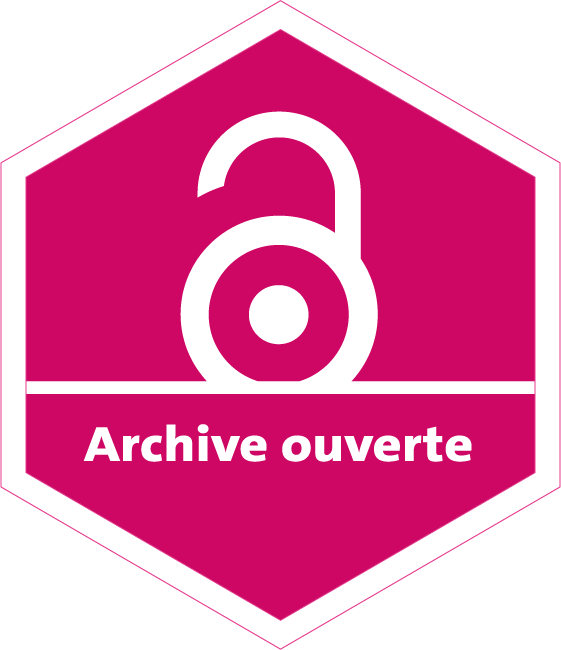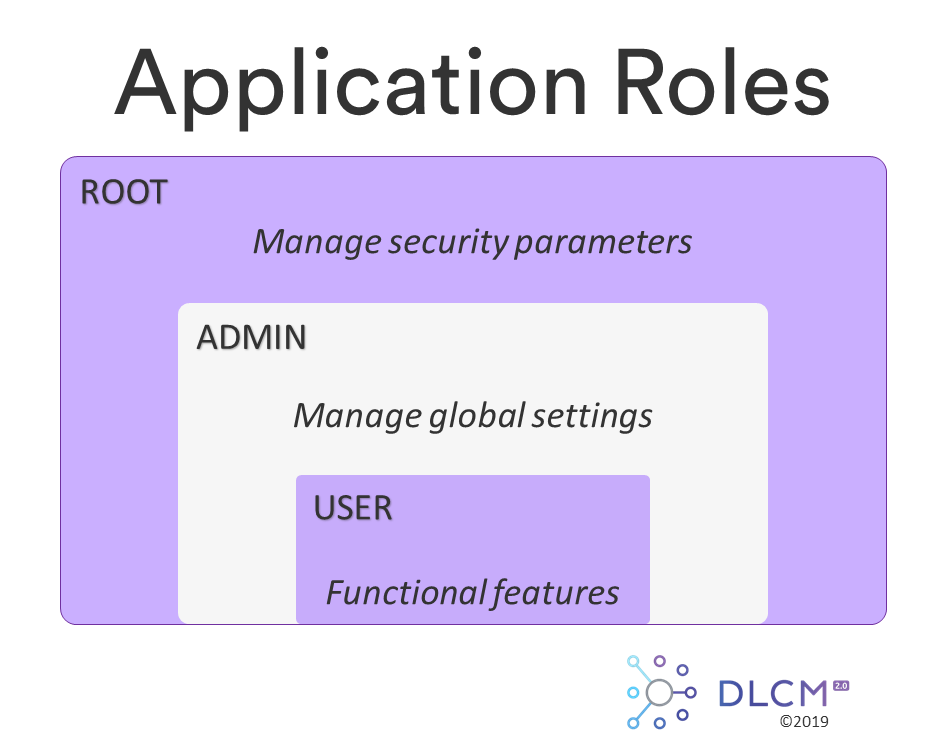1. AoU Architecture
The solution architecture is open, flexible and modular so as to be scalable, sustainable, and to facilitate its integration with other information systems. How such integrations can be performed constitutes the topic of this document.
2. Integration Points
2.1. For Submitting Publications
See the details in Integration for Submitting Publications section.
2.2. For Searching Publications
See the details in Integration for Searching Publications section.
2.3. For Developers
-
All web services are detailed in API Documentation.
-
The API are available in OpenApi v3 format. The definition is available in AoU API JSON file.
3. REST Web Services
3.1. Overview
The AoU APIs are RESTful web services based on the best practices. The implementation corresponds to the third level of Leonard Richardson’s Maturity Model:
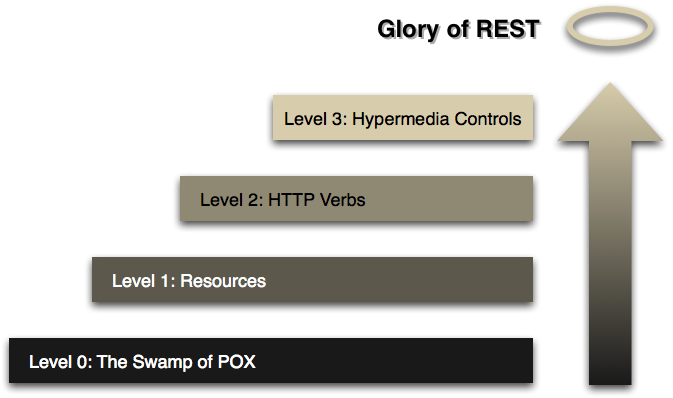
Source : (crummy.com, 2008)
More details about these concepts are available on the following links:
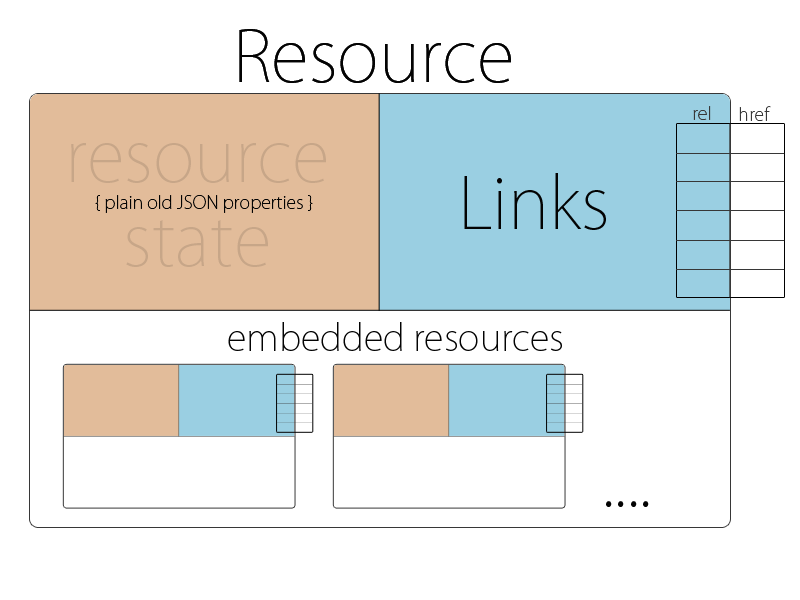
Source : (stateless.co, 2011)
3.1.1. URL Structure
The URL of each REST resource is constructed according to the following rule:
http(s)://<root context>/<module>/<things>
Where:
-
http(s)is the protocol which can be secured depending on the installation configuration. -
<root context>is the root context of the application, defined in the configuration. -
<module>is the functional module (see AoU Architecture): the different module names are detailed in the AoU Modules section in the Annexes. -
<things>is the name of the REST resource: it must be a *noun in plural form*.
The naming convention, applied only for <things>, respects the camel case syntax, with a lower case character for the first one.
| There are some examples of root contexts in the demo environment |
3.1.2. CRUD Operations
By default, for each REST resource, the CRUD actions are available like this:
| HTTP verb | CRUD action | Collection | Instance |
|---|---|---|---|
|
Create |
✔ |
✘ |
|
Read |
✔ |
✔ |
|
Update No creation |
✘ |
✔ |
|
Delete |
✘ |
✔ |
The HTTP verb for an action on a resource is POST:http(s)://<root context>/<module>/<things>/<thingID>/<action>.
|
3.1.3. HTTP Status Codes
RESTful notes tries to adhere as closely as possible to standard HTTP and REST conventions in its use of HTTP status codes.
| Status code | Usage |
|---|---|
|
The request completed successfully |
|
A new resource has been created successfully. The resource’s URI is available from the response’s
|
|
An update to an existing resource has been applied successfully |
|
The request was malformed. The response body will include an error providing further information |
|
Authentication is required to access to this resource |
|
You are not allowed to access to this method for this resource |
|
The requested resource did not exist |
|
The requested method is not supported for this resource |
3.1.4. Error Details
{
"path": "http(s)://<root context>/<module>/<things>",
"status": "BAD_REQUEST",
"error": "Type of error",
"message": "Message to explain the issue",
"timeStamp": "DDD MMM YY hh:mm:ss CEST YYYY",
"statusCode": 400
}Contains the malformed request information, which describes the problem on the request:
-
The path field is the url of the resource concerned by the problem.
-
The status field is the status of the request (always 'BAD_REQUEST' in this case).
-
The error field is the error that occurs on the request.
-
The message field is the message that details the problem.
-
The timeStamp field is the time at which the error occurred.
-
The statusCode field is the status code of the request (always '400' in this case) .
In the case in which a body object is provided, the validationErrors field is also added to the fields above. The value of this field is an array that contains for each malformed field:
-
The fieldName field that contains the name of the malformed field.
-
The errorMessages field array that contains the list of errors in this field.
| Example of a deposit submission with a malformed body = {} |
{
"path": "http(s)://<root context>/<module>/<things>",
"status": "BAD_REQUEST",
"error": "None",
"message": "Validation failed",
"timeStamp": "Fri May 17 11:39:15 CEST 2019",
"validationErrors": [
{
"fieldName": "title",
"errorMessages": [
"can't be null"
]
},
{
"fieldName": "description",
"errorMessages": [
"can't be null"
]
},
{
"fieldName": "organizationalUnitId",
"errorMessages": [
"can't be null"
]
}
],
"statusCode": 400
}| Example of a malformed deposit submission with no body |
{
"path": "http(s)://<root context>/<module>/<things>",
"status": "BAD_REQUEST",
"error": "Required request body is missing: ...",
"message": "Request not readable",
"timeStamp": "Fri May 17 12:53:29 CEST 2019",
"statusCode": 400
}| Example of a malformed deposit submission with a body = [] |
{
"path": "http(s)://<root context>/<module>/<things>",
"status": "BAD_REQUEST",
"error": "JSON parse error: ...",
"message": "Request not readable",
"timeStamp": "Fri May 17 13:04:39 CEST 2019",
"statusCode": 400
}3.2. Collection
A collection of REST resources is a list of JSON objects. The list has its own structure, is paginated, filterable and sortable.
The collection URL is:
http(s)://<root context>/<module>/<things>.
3.2.1. Structure
{
"_data" : [
{ "object" : "#1" },
{ "object" : "#2" },
{ "object" : "#3" },
{ "object" : "#4" }
],
"_page": {
"currentPage" : 0,
"sizePage" : 20,
"totalPages" : 1,
"totalItems" : 4
},
"_links" : {
"self" : {
"href" : "URL of the collection"
},
"module" : {
"href" : "URL of the DLCM module"
}
}
}Data Section
The Data section contains an array of JSON representations, corresponding to business objects (i.e. things). The details of these objects can be found in the technical documentation (i.e. API Documentation) provided with the DLCM solution.
Page Section
The Page section contains the pagination information, which describes the current position:
-
The currentPage field is the page number of the current page: it starts at 0.
-
The sizePage field is the size of each page: the default is set to 20, the max value is 2000.
-
The totalPages field is the total number of pages for the current page size.
-
The totalItems field is the total number of objects for the current selection.
Links Section
The Links section contains the links corresponding to the current collection. This list is dynamic and depends on the state of the collection:
-
The self link is the current URL: it is always present.
-
The module link is the URL to access the current module.
-
The next link is the URL to go to the next page, available only if it exists.
-
The previous link is the URL to go to the previous page, available only if it exists.
-
The lastCreated link is the URL to get the list sorted by creation date in descending order.
-
The lastUpdated link is the URL to get the list sorted by last update date in descending order.
-
Some other links could be available depending on the current resource: these links are detailed in the API documentation of the resource.
| Example of institution list |
{
_data : [
{
resId : "7f9df7bb-5eab-4823-98a0-abb668731de5",
name : "UNIGE",
description : "Université de Genève",
},
{
resId : "18284eb1-de0b-427e-9e8c-c541cb35e818",
name : "EPFL",
description : "Ecole Polytechnique Fédérale de Lausanne",
},
{
resId : "e8a9b74d-7b84-4958-be62-9b0b1d83a360",
name : "ETH",
description : "ETH Zürich",
}
],
_page : {
currentPage : 0,
sizePage : 20,
totalPages: 1,
totalItems: 4
},
_links: {
self : {
href : "http://localhost:16105/dlcm/admin/institutions"
},
module : {
href : "http://localhost:16105/dlcm/admin"
},
lastCreated : {
href : "http://localhost:16105/dlcm/admin/institutions?sort=creation.when,desc"
},
lastUpdated : {
href : "http://localhost:16105/dlcm/admin/institutions?sort=lastUpdate.when,desc"
}
}
}3.2.2. Usage
To get a list of things
The different parameters can be used individually or together.
Request |
|
|
|---|---|---|
Verb |
GET |
|
Parameter(s) |
Name |
Description |
|
The page size |
|
|
The current page number |
|
|
To apply a filter on a field
if the field is embedded in a sub structure, the field name must be fully named with “.” for each level:+
|
|
|
To sort a field |
|
Expected |
|
Success |
Return Object |
JSON Collection object |
See Structure |
| Examples |
-
To filter by creation date:
http(s)://<root context>/<module>/<things>?sort=creation.when -
To sort by most recent objects:
http(s)://<root context>/<module>/<things>?sort=creation.when,desc -
To get page 10 composed of 5 elements:
http(s)://<root context>/<module>/<things>?page=10&size=5
3.3. Instance
The instance of REST resource is the instance of an object with its fields.
The instance URL is:
http(s)://<root context>/<module>/<things>/<thingID>.
3.3.1. Structure
{
"creation" : {
"when" : "Creation date & time",
"who" : "Creation user"
},
"lastUpdate" : {
"when" : "Last update date & time",
"who" : "Last update user"
},
"resId" : "Object ID",
"fields" : "Object fields...",
"_links" : {
"self" : {
"href" : "URL of the object"
},
"list" : {
"href" : "URL of the object collection"
},
"module" : {
"href" : "URL of the DLCM module"
},
"Other link" : {
"href" : "Others links of the object"
}
}
}The field list elements are:
-
The creation and lastUpdate fields, containing the information of the action:
-
The when field is the date and the time, with milliseconds of the action (ex : 2018-03-08T17:42:30.733+0100).
-
The who field is the user id of the user who has done the action.
-
-
The resId field is the identifier of the object: it is a UUID.
-
Some other fields complete the object description: these fields are detailed in the technical documentation of the resource.
Links Section
The links section contains a list of links of the object:
-
The self link is the URL of the current object.
-
The list link is the URL pointing to the object collection.
-
The module link is the URL to access the current module.
-
Some other links could be available depending on the object: these links are detailed in the technical documentation of the resource.
| Example of an institution |
{
"creation" : {
"when" : "2018-03-08T17:42:30.733+0100",
"who" : "user id of user xxxxxx"
},
"lastUpdate" : {
"when" : "2018-03-08T17:42:30.733+0100",
"who" : "user id of user yyyyyyy"
},
"resId" : "7f9df7bb-5eab-4823-98a0-abb668731de5",
"name" : "UNIGE",
"description" : "Université de Genève",
"_links" : {
"self" : {
"href" : "http://localhost:16105/dlcm/admin/institutions/7f9df7bb-5eab-4823-98a0-abb668731de5"
},
"list" : {
"href" : "http://localhost:16105/dlcm/admin/institutions"
},
"module" : {
"href" : "http://localhost:16105/dlcm/admin"
},
"people" : {
"href" : "http://localhost:16105/dlcm/admin/institutions/7f9df7bb-5eab-4823-98a0-abb668731de5/people"
},
"organizationalUnit" : {
"href" : "http://localhost:16105/dlcm/admin/institutions/7f9df7bb-5eab-4823-98a0-abb668731de5/organizationelUnits"
}
}
}3.3.2. Usage
To get a resource
Request |
|
|
|---|---|---|
Verb |
GET |
|
Parameter(s) |
Name |
Description |
|
- |
|
Expected |
|
Success |
|
Not found |
|
Return Object |
JSON object |
See Structure |
To create a new resource
Request |
|
|
|---|---|---|
Verb |
POST |
|
Parameter(s) |
Name |
Description |
|
Object in JSON format. The fields and the structure depend on the type: see API Documentation |
|
Expected |
|
Created |
Return Object |
|
See Structure |
To update a resource
The resource must already exist.
Request |
|
|
|---|---|---|
Verb |
PATCH |
|
Parameter(s) |
Name |
Description |
|
Object in JSON format. The fields and the structure depend on its type: see API Documentation |
|
Expected |
|
Modified |
|
Not modified |
|
|
Not found |
|
Return Object |
|
See Structure |
To delete a resource
Request |
|
|
|---|---|---|
Verb |
DELETE |
|
Parameter(s) |
Name |
Description |
|
- |
|
Expected |
|
Deleted |
|
Not found |
|
|
Gone |
|
Return Object |
|
If success |
3.4. Security
3.4.1. Authentication
All web services are secured and require authentication.
User authentication relies on Switch AAI which is a Single Sign-On (SSO), based on Shibboleth.
Access to Web services relies on OAuth 2.0 access delegation.
OAuth 2.0 is a protocol allowing third-party applications to grant limited access to an HTTP service, either on behalf of a resource or by allowing the third-party application to obtain access on its own. It uses the authorization code grant implementation.
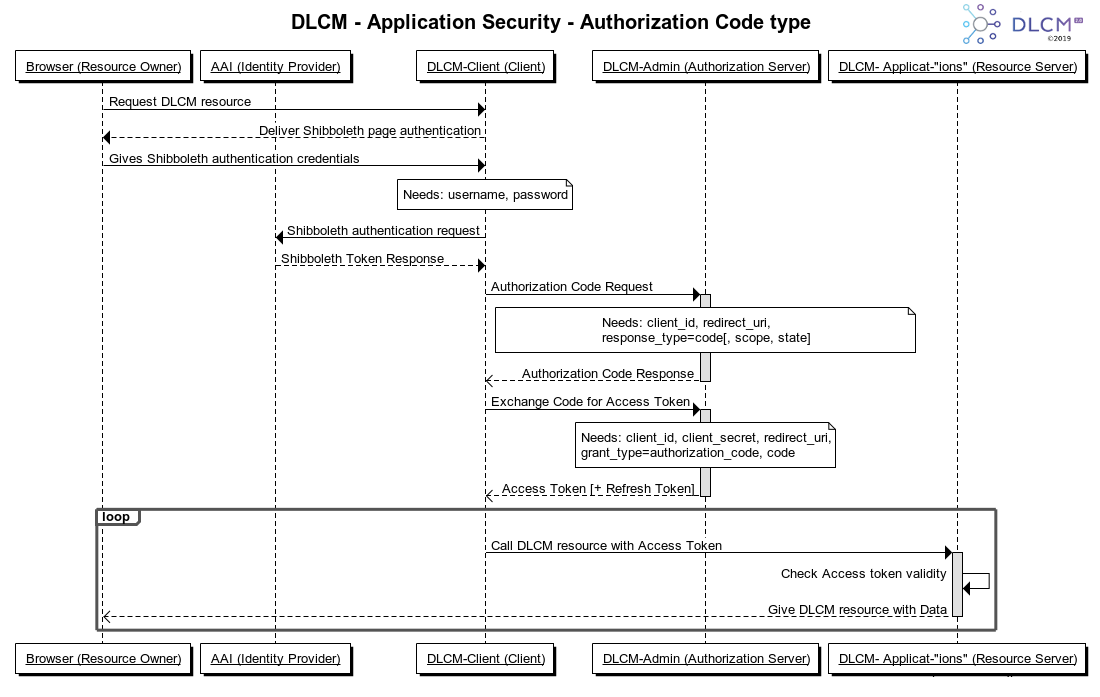
5. Integration for Searching Publications
5.1. To export metadata with OAI-PMH
The OAI-PMH provider of DLCM solution supports version 2.0 of the protocol for metadata harvesting. The specifications are detailed on the Open Archives Initiative website.
Request |
|
|
|---|---|---|
Verb |
GET or POST with content-type application/x-www-form-urlencoded |
|
Parameter(s) |
Name |
Description |
|
||
|
Optional parameter to display OAI XML in a structured way, with XML transformation to generate HTML. |
|
Expected |
|
Success |
|
Service unavailable, i.e. the Data Management module is not running |
|
Return |
|
OAI-PMH XML data. See OAI-PMH specifications |
Roles |
Public (see [roles]) |
|
6. Annexes
6.1. Glossary
| Acronym | Description | Source |
|---|---|---|
CRUD |
Create Read Update Delete |
Software |
HAL |
Hypertext Application Language |
Software |
HATEOAS |
Hypermedia As The Engine Of Application State |
Software |
JSON |
JavaScript Object Notation |
Software |
REST |
REpresentational State Transfer |
Software |
SOA |
Service Oriented Architecture |
Software |
6.2. AoU Modules
| Module | Description | REST Name |
|---|---|---|
Access |
Access module to access to publication |
access |
Admin |
Administration module to manage general settings |
admin |
